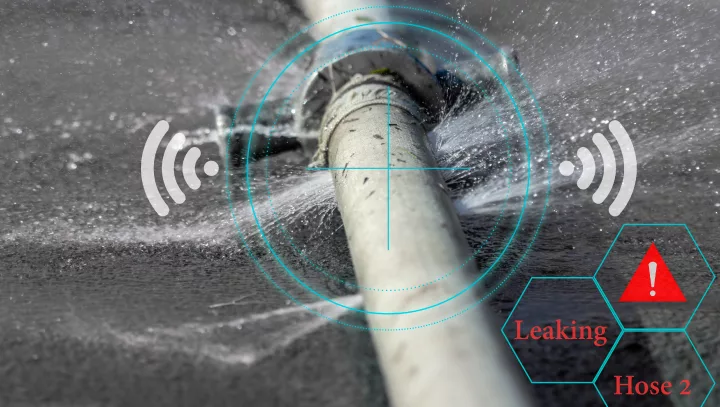Advanced Water Leak Detection Solutions for Your Home and Business
Advanced Water Leak Detection Solutions for Your Home and Business
Blog Article
Innovative Solutions for Very Early Detection of Water Leaks in Structures and Framework
From cutting-edge leakage detection innovations to the deployment of IoT sensing units for real-time tracking, the landscape of leakage prevention is developing rapidly. Automated water circulation evaluation systems are improving exactly how leakages are determined and dealt with, paving the means for an aggressive method to water leakage discovery.
Advanced Leak Discovery Technologies
Advanced leak detection modern technologies, furnished with sophisticated sensing units and algorithms, play a critical duty in swiftly identifying and identifying water leaks in various setups. These innovations employ a combination of acoustic, thermal, and electromagnetic picking up techniques to detect leakages precisely. Acoustic sensors find the noise of running away water, permitting precise localization of the leak source. Thermal imaging finds temperature modifications triggered by water leakage, supplying another effective approach for leak identification. Electromagnetic sensors can identify modifications in electromagnetic fields brought on by water, providing yet one more layer of leak discovery ability.

IoT Sensors for Real-Time Monitoring
In the realm of contemporary water leakage detection, the integration of IoT sensing units for real-time surveillance stands for a pivotal innovation in boosting aggressive leakage discovery capacities. These sensors use constant monitoring of water supply, providing real-time information on water flow prices, pressure variations, and temperature adjustments. By leveraging IoT modern technology, these sensors can identify even the tiniest anomalies in water usage patterns, enabling very early identification of potential leakages prior to they escalate into major issues.
IoT sensing units send data to a central system, where sophisticated algorithms evaluate the information and create notifies or notifications when abnormalities are identified. This real-time monitoring capacity enables building owners or center supervisors to quickly resolve leakages, minimizing water damages, lowering repair work costs, and conserving water resources.
Additionally, IoT sensors can be incorporated with structure monitoring systems, permitting automatic reactions to found leakages, such as turning off water shutoffs or turning on pumps to reduce the influence of leakages. Generally, the implementation of IoT sensing units for real-time monitoring significantly enhances the efficiency and effectiveness of water leak detection in buildings and framework.
Equipment Learning Algorithms for Leakage Prediction

One trick advantage of utilizing artificial intelligence for leak forecast is its capability to continually discover and improve its accuracy gradually. As even more data is accumulated and fed into the algorithm, it can improve its predictions and adjust to altering problems, ultimately enhancing the reliability of my company leak discovery systems.
Moreover, artificial intelligence algorithms can help in recognizing subtle indications of leakages that may go unnoticed by standard tracking methods. water leak detection. By assessing intricate information collections in real-time, these formulas can supply early cautions and informs, enabling punctual intervention and precautionary maintenance to alleviate possible water damages and associated prices
Using Thermal Imaging for Leakage Detection
Thermal imaging technology supplies a promising approach for finding water leaks in numerous systems and frameworks. By utilizing infrared radiation and temperature level variances, thermal imaging video cameras can recognize covert leakages that are not conveniently noticeable to the nude eye. When water runs away from pipelines or structures, it commonly alters the temperature of the bordering location, producing temperature level differentials that thermal electronic cameras can catch. These temperature irregularities are then equated right into browse around this site visible pictures, highlighting the precise location of the leak.
Among the vital advantages of thermal imaging for leakage discovery is its non-intrusive nature. Unlike conventional methods that might call for burglarizing wall surfaces or floorings to situate leakages, thermal imaging permits for non-destructive screening. This not just conserves time and decreases prices yet also lessens disruption to the building or infrastructure being analyzed. In addition, thermal imaging can quickly check big locations, supplying an extensive summary of prospective leak sources in a timely manner. Generally, the use of thermal imaging innovation boosts the performance and precision of water leakage detection, making it an important device for preserving the stability of buildings and infrastructures.
Automated Water Circulation Analysis Equipments
Exactly how can computerized water circulation evaluation systems transform the detection and monitoring of leakages in various systems and facilities? Automated water flow analysis systems provide a positive strategy to leakage discovery by continually checking water flow prices and patterns. By establishing baseline data, these systems can rapidly determine variances that might suggest a leak, allowing prompt intervention to stop comprehensive damage.
These systems utilize advanced algorithms to evaluate real-time information and supply instant alerts when anomalies are detected, enabling for speedy activity to be taken. Furthermore, automatic water circulation evaluation systems can be integrated with building administration systems or IoT systems, enhancing overall performance and allowing remote surveillance abilities.
In addition, the information accumulated by these systems can be utilized for anticipating upkeep functions, helping to identify prospective weak factors in the infrastructure before leaks happen. Overall, the implementation of visit our website automatic water circulation analysis systems can significantly improve leak discovery and administration methods, ultimately causing set you back financial savings, decreased water wastefulness, and boosted sustainability in buildings and facilities.

Final Thought
To conclude, the integration of advanced leak detection modern technologies, IoT sensing units, artificial intelligence formulas, thermal imaging, and automated water flow analysis systems supplies innovative remedies for very early detection of water leaks in buildings and framework. These innovations enable real-time surveillance, prediction of leaks, and reliable discovery approaches to stop water damage and wastage. Carrying out these solutions can aid in preserving the honesty and sustainability of water systems in different setups.
Report this page